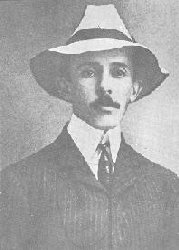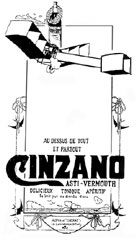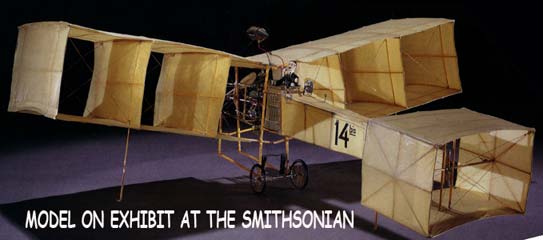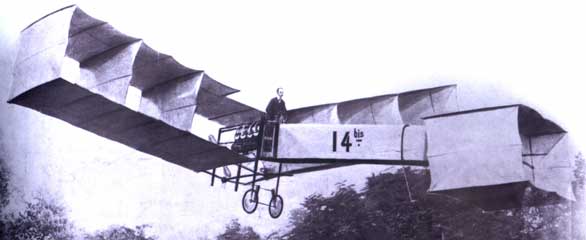


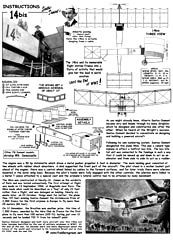
DuMont 14-BIS - $$4.95
The 14-bis, also known as Oiseau de proie (French for "bird of prey"), was a pioneer-era canard biplane designed and built by Brazilian inventor Alberto Santos-Dumont. On October 23, 1906, in Paris, France, it performed the first officially witnessed European unaided takeoff and flight by a heavier-than-air aircraft.
Alberto Santos Dumont's Early Flyer 14 Bis
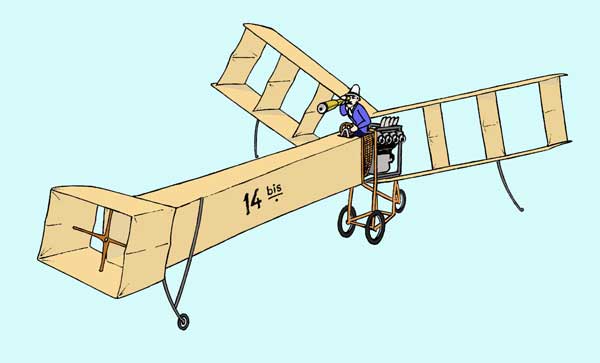
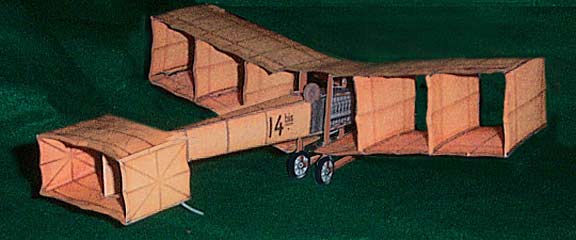
By the standard of what the Wright brothers had achieved by this date, Santos's uncontrolled hop, which ended in the collapse of his undercarriage, was scarcely a milestone in the history of aviation. But the onlookers, who had gathered at the Bois de Boulogne, were transfixed and convinced that they had witnessed the world's first airplane flight.
"Many and great are the aeronautical achievements of mankind in this century; little less than 68 years after Santos-Dumont flew around the Eiffel tower, the U.S. astronaut Neil Armstrong walked on the Moon, on 20 July 1969 -- exactly on the 96th anniversary of Santos-Dumont's birthday. A strange coincidence, which makes us admire even more the achievements of that Brazilian, truly Father of the Aviation."
Dumont's 14-bis Early Flyer
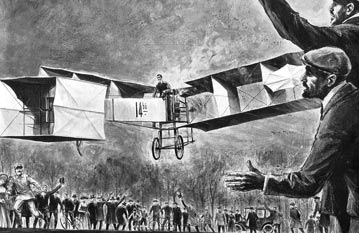
On 17 December 1903, the Wright brothers, in the USA, made use of a rudimentary catapult (with an inclined plane) to throw their Flyer biplane into the air, Santos-Dumont, however, would be the first to build and fly an aircraft "heavier-than-the-air" by its own means of propulsion.
A diminutive man of fierce determination and unpredictable moods, Santos was determined to gain recognition as the leading aeronaut of France. To encourage the development of aeronautics, the rich petroleum magnate Henry Deutsch de la Meurthe had created a prize of 100,000 francs ($20,000) to be awarded to the first person who flew successfully from the Parisian suburb of Saint Cloud to the Eiffel Tower, rounded it, and then returned to Saint Cloud in a total time of thirty minutes or less. In September 1901, after several failures, the Brazilian won the prize and established his primacy over his French rivals.
|
|
Between 1901 and 1905, Santos was satisfied to enjoy his fame and to titillate
the Parisian public by landing his dirigible in front of his house just
off the Champs-Elyses or at his favorite restaurant in the Bois
de Boulogne. In 1906, however, the Brazilian surprised the Parisian aeronautical
world by announcing that he intended to become a contender for the prizes
being offered for heavier-than-air flight. Just two years before he had
suggested that the conquest of the air by means of heavier-than-air machines
might occur... but, as news of the Wright brothers' experiments appeared
in French aeronautical journals, Santos began to wonder if the future
were not closer at hand.
He was there watching Gabriel Voisin soar briefly above the waters of the Seine in an aircraft of his own design and he was prompted to act. Inspired by Voisin's use of box-like structures to provide stability, Santos designed one of the strangest and least promising flying machines ever seen, which he christened the I4bis to indicate its continuity with the fourteen dirigibles that had preceded it. On the afternoon of 23 October 1906 the Brazilian succeeded in rising to a height of three meters, which he maintained over a distance of two hundred feet, thereby winning the Archdeacon prize for the first heavier-than-air flight of more than 25 meters.
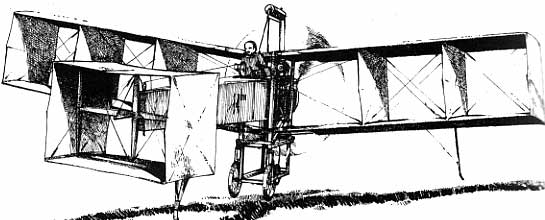
By the standard of what the Wright brothers had achieved by this date,
Santos's uncontrolled hop, which ended in the collapse of his undercarriage,
was scarcely a milestone in the history of aviation. But the onlookers,
who had gathered at the Bois de Boulogne, were transfixed and convinced
that they had witnessed the world's first airplane flight. "The stupefied
crowd had the impression of a miracle; struck dumb with admiration at
first, they shouted with enthusiasm at the moment of the landing, and
carried the aviator away in triumph. On 12 November, after fitting the
I4bis with primitive ailerons," Santos flew again, extending his
distance covered in the air to 722 feet.
The Daily Mail announced ominously that the flight of Santos-Dumont had
an international significance. "The air around London and other large
cities will be darkened by the flight of aeroplanes ... They are not mere
dreamers who hold that the time is at hand when air power will be an even
more important thing than sea power.'
Santos-Dumont never accepted that his invention could be used for war purposes, which was so very well proved during the Great War of 1914-1918. He believed that an airplane was to be used to foster the well-being of people, as a means of transportation, and for leisure as well, as he had shown when traveling on his aircraft in Paris to go to the Opera or visit friends. He went back to Brazil and died on 23 July 1932, at the town of Guaruju, State of Sao Paulo.
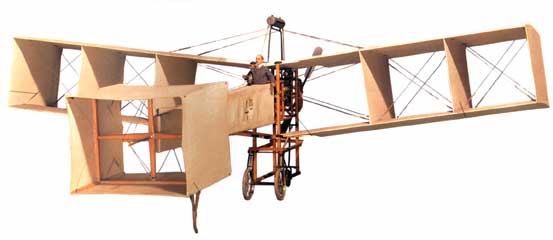
Santos-Dumont 14bis.
Alberto Santos-Dumont's 14bis made the first powered flights in Europe
during the Autumn of 1906. It flew tail-first and influenced Bleriot's
first monoplane, the Canard, which lent its name to all other such aircraft.
The 14bis was constructed from pine and bamboo poles covered with Japanese silk. Its propeller was made from steel shafts with aluminum blades. The boxkite cell in the nose pivoted up and down to act as an elevator and from side to side in the role of a rudder. The wings were rigged with 10 degrees of dihedral and the first flights were made without ailerons. (Octagonal ailerons were fitted between the wings from November 1906, these being controlled through a body harness worn by the pilot, who flew standing up.)
The original power-plant was a 24 hp Antoinette engine, but this was upgraded to the 50 hp version from October. The 14bis made its last flight on 14 April 1907.
|
|
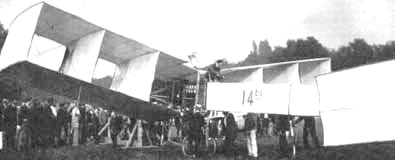 |
In 1906, Santos-Dumont took the nacelle of his dirigible balloon no.
14 and added to it a fuselage and biplane wings, whose cellular structure
resemble huge box kites. An Antoinette V8 engine of 24 hp was installed ahead
of the wings, driving a pusher propeller.The airplane flew canard style (rear-first)
and was denominated 14-bis (since it was descendent of the dirigible
balloon no. 14).
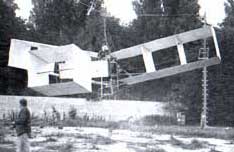 |
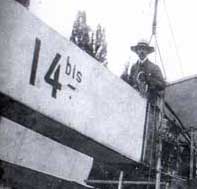 |
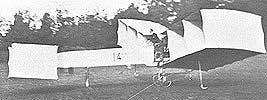 |
The historic flight of Santos-Dumont on the 14-bis at Bagatelle:
On
the 23rd of October, Santos-Dumont flew from the field of Bagatelle, watched
by a crowd and representatives of the Aero Club of France. By his own means
of propulsion, the 14-bis rolled for approx 300 feet and took off, flying
for 250 feet in 7 seconds, in a level flight a few feet above ground. Santos-Dumont
won the 3,000 francs Prize Archdeacon, instituted in July 1906 by the American
Ernest Archdeacon, to honor the first flyer to achieve a level flight of at
least 75 feet.
On 12 November 1906, Santos-Dumont improved even more the performance of his 14-bis and his flying ability, making several flights always increasing the distance flown, finally flying for 21.5 seconds at about 20 feet above ground, covering 700 feet at a speed of 25 mph.
This is a drawing of the 50 hp Antoinette engine Santos-Dumont
ended up using in his 14bis 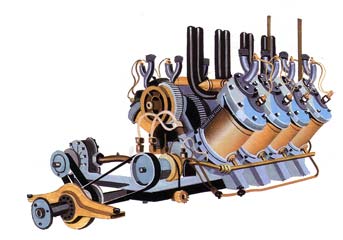 |
|
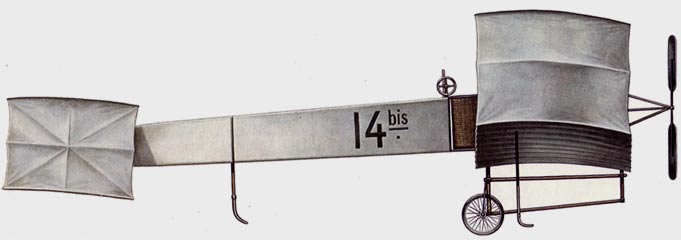
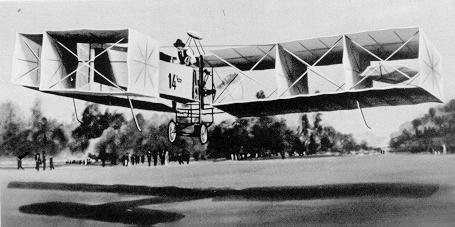 |
|
A little more about the 14bis...
Alberto Santos-Dumont became very well known through his many dirigibles, which he designed and constructed one after the other. When he heard of the Wright's success, he decided to concentrate on designing and building a powered aircraft. Following his own numbering system, Santos-Dumont designated this plane l4bis. It was a canard type biplane-in effect a tail first box kite. The box kite tail unit was connected to the fuselage in such a way that it could be moved up and down to act as an elevator and from side to side to act as a rudder. The engine was a 50 hp Antoinette which drove a metal pusher propeller 6 feet in diameter. The main landing gear consisted of two wheels with rubber shock absorbers. A skid supported the front part of the aircraft. The pilot stood in a wicker basket just ahead of the engine; there was a control wheel linked by cables to the forward surfaces, and for later trials there were ailerons mounted in the outer wing bays. Because the pilot's hands were fully engaged with the other controls, the ailerons were linked to a metal T-piece attached to a special coat and the airplane's lateral control had to be attained by body movement.
The l4bis was constructed at Neuilly-St. James on the outskirts of Paris and was tested exhaustively. The first attempt at flight was made on 13 September 1906, at Bagatelle near Paris. The l4bis made what could be described as a "hop" of only 23 feet rather than a flight, and was damaged on landing. Nearly six weeks later, on 23 October, things went far better: the plane flew 197 feet winning Santos-Dumont the Archdeacon Prize of 3,000 francs for the first airplane in Europe to fly more than 80 feet. On 12 November, the Brazilian won another prize, this time of 1,500 francs, awarded by the Aero Club de France for the first plane to fly more than 328 feet; on this occasion his flight lasted just over 21 seconds and he landed 722 feet from his takeoff point.
Santos-Dumont persevered with his interest in heavier-than-air machines and succeeded in flying a new model, the Santos-Dumont No. 20 Demoiselle which bore far more resemblance to the airplane as we know it than the l4bis. This little monoplane made its debut at St. Cyr in March 1909. The true prototype of the Demoiselle, however, had been built nearly two years previously. It had been designated project No. 19 and had made hops in 1907. It had a 20 hp engine, and a bamboo fuselage with cruciform tail surfaces and a framework beneath the wings which housed the pilot and the landing gear.
The No. 19 was not an exceptional aircraft, and after two short hops on 17 November 1907, when it failed to fly any higher than 656 feet and was damaged on landing, Santos Dumont decided not to make any more tests with this model and redesigned the wing and fitted a more powerful engine to complete his No. 20 Demoiselle. The fuselage of the Demoiselle No. 20 was still of bamboo, but strengthened, the wing area was the same, but it was powered by a 35-hp engine. During tests in September 1909 it succeeded in flying for 16 minutes, covering about 11 miles. The much modified No. 19 was exhibited during that same month at the Grand Palace in Paris and was received with considerable enthusiasm. Santos-Dumont allowed anyone to copy his aircraft and it is believed that between ten and fifteen Demoiselles were built.
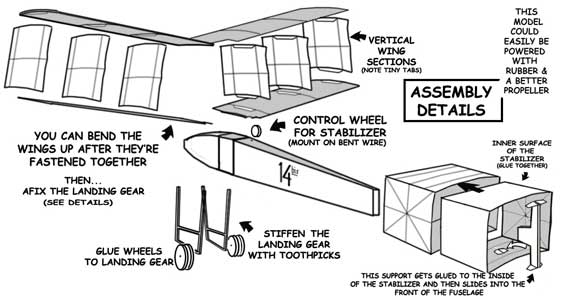
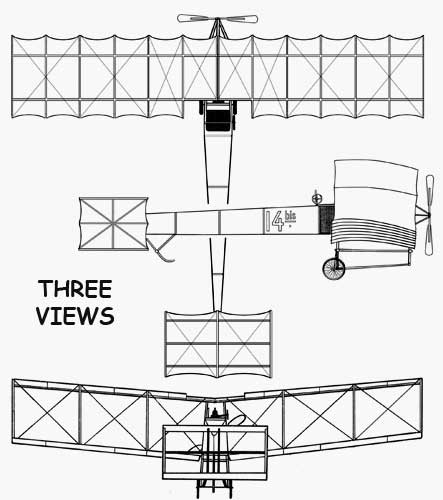
Specifications for the Dumont 14-bis
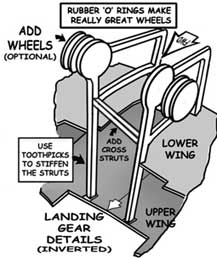 |
Span: 36 ft. 9 in.
Length: 31 ft. 10 in Height approx: 11 ft. 2 in Wing area: 560 sq.ft. Take-off weight: 661 lb. Speed approx: 25 mph Santos-Dumont developed what has to be called the
first flight simulator, using winches and gears to let the 14-bis roll down an inclined plane, while he learned how to control the plane. |



